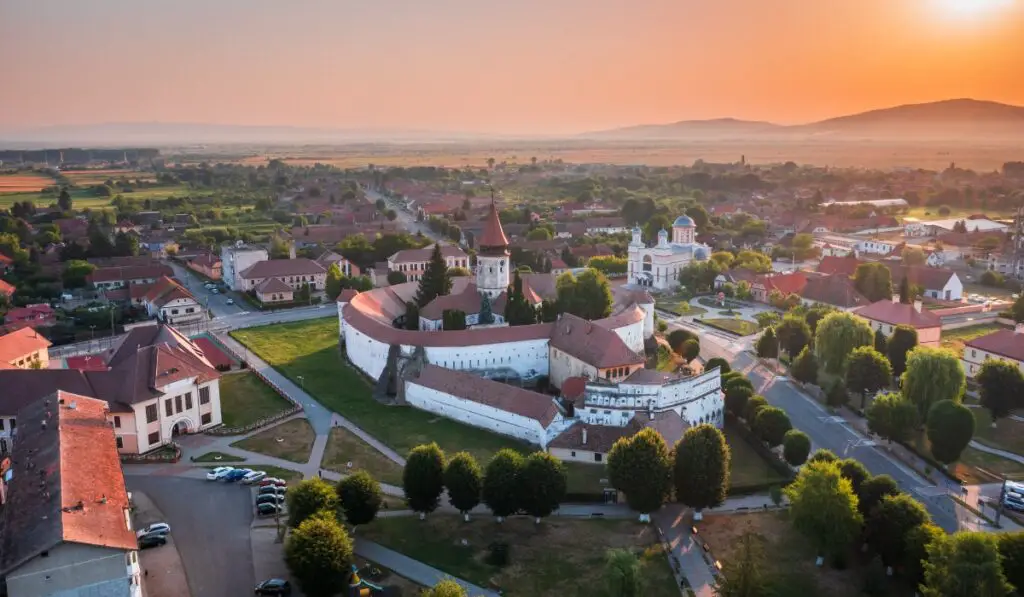This post may contain affiliate links. At no cost to you, purchases made through these links may result in a small commission for Traveling Transylvania. We never recommend products that we don’t know and trust. Thank you for your continued support!
You know, before I set foot in Romania, I thought Transylvania was all about Dracula, spooky castles, and maybe the occasional garlic clove to ward off those pesky vampires. But lo and behold, tucked away in the picturesque landscapes of Transylvania, I stumbled upon a beautiful village that stole my heart: Prejmer.
Now, Prejmer might not be on every traveler’s bucket list, but let me tell you—it sure deserves a spot! Not just for its tranquil village vibes or the friendliest locals you’ll ever meet (who, by the way, have never once tried to bite my neck). No, the true gem of Prejmer is its fortified church. A majestic testament to history, architecture, and a dash of Transylvanian resilience.
If you’ve ever wondered what it feels like to step back in time while enjoying the comforts of the present (and maybe a pinch of my expat quirks), Prejmer’s fortified church is your answer. Stick around, and let me regale you with tales, tidbits, and maybe a chuckle or two about this hidden wonder in Romania’s heartland.
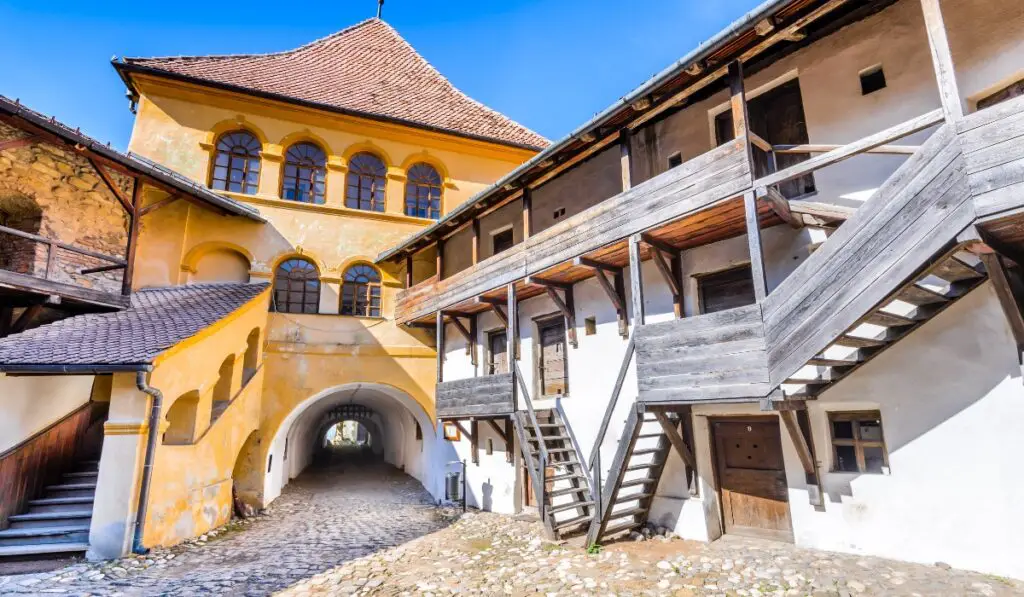
Unraveling the History of Prejmer’s Fortified Church
The tales of Transylvanian history are as layered as its landscapes, and Prejmer’s fortified church offers one of the most compelling chapters. So, where does this story begin?
Well, rewind the clock to around 1211. King Andrew II of Hungary thought it would be quite a noble gesture to let the Teutonic knights settle around Prejmer. And so, by 1218, these industrious knights were knee-deep in constructing a church. Unique to Transylvania, this Gothic design might seem foreign to many, but it resonates with churches in the far reaches of northeast Germany.
Yet, the knights’ tenure was short-lived, and by 1225, they were shown the door. Enter the Cistercians in 1240, who took it upon themselves to complete the church. Their influence shines through in many elements, and I always marvel at the dedication it must have taken to add their touch.
And speaking of touches, let’s talk art. Prejmer is home to the oldest altarpiece in the province, dating back to circa 1450. And oh, what a sight it is! This triptych masterpiece is dominated by a magnificent depiction of the Crucifixion – four times the size of other panels and shimmering with gold. Surrounding it are vivid portrayals of various events from the Passion of Christ, each rendered with a striking balance of simplicity and vivid color. The identity of the artist remains a mystery, but whispers suggest a background from the Viennese school.
In terms of modifications, the church wasn’t left untouched. 1461 saw the addition of a bell tower, and between 1512 and 1515, architectural renovations transformed its Greek cross shape. Yet, amidst these changes, a distinct absence of frescoes and the removal of 19th-century paintings during restoration means that the interior remains charmingly simple.
Now, here’s where things get exciting (and a bit action-movie-esque). Given its location, Prejmer was the unfortunate “welcome committee” whenever Ottoman forces or other invaders came through the Buzău Pass. And while the village faced devastation over 50 times between the 13th and 17th centuries, our fortified church proved a tough nut to crack. Its fortifications, bolstered in the 15th-16th centuries, featured imposing walls, a water-filled moat, and even whispers of a secret tunnel leading out of the church.
With walls up to 5 meters thick and standing nearly 12 meters tall, the church was a fortress of unparalleled might. It also housed over 270 rooms that could shelter around 1600 villagers during attacks. Entry? Well, that was through a 30-meter tunnel, guarded by a hefty portcullis and sturdy oak doors. Not to mention the impressive barbican that stood as an imposing guardian.
Then there’s the “organ of death” – and no, it’s not a spooky musical instrument. This medieval contraption was outfitted with ten shotguns, making it a rotating powerhouse against foes. It’s said to have wreaked havoc in the enemy lines, truly a testament to the innovation of the time.
The fortified church saw its share of changes, with the last significant modifications in the 18th century. But come 1960-1970, meticulous restoration returned Prejmer to its original glory. Nowadays, it stands as a museum, offering visitors a deep dive into history. And if that wasn’t accolade enough, in 1999, Prejmer joined the ranks of UNESCO World Heritage Sites, listed along with other fortified churches in Transylvania.
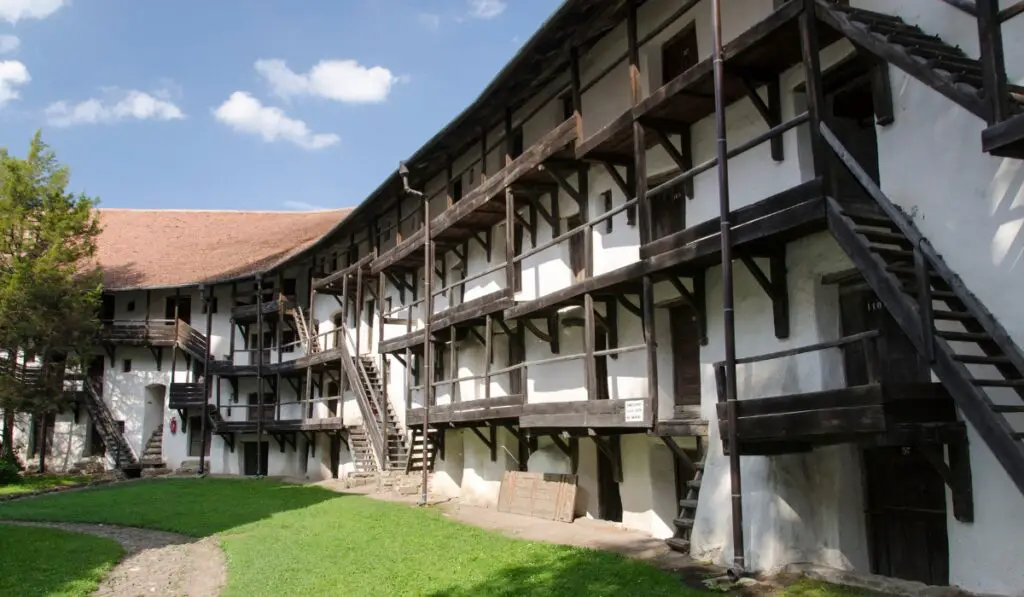
Why “Fortified”? The Defensive Brilliance of Prejmer
You know, the first time I heard the term “fortified church”, I remember chuckling and thinking, “What’s next? Battle-ready monasteries?” But as I ventured deeper into the heart of Transylvania, I soon realized that the fortified church of Prejmer wasn’t just a blend of sacred and soldierly – it was a symbol of resilience, community, and architectural genius.
The Need for a Fortified Church
The lands of Transylvania have always been a melting pot of cultures, trades, and yes, invasions. Villages like Prejmer, situated at crossroads and often in the path of invasions, needed more than faith to protect them. They needed walls. Thick, towering, uncompromising walls. And so, in a move of architectural innovation and strategic brilliance, places of worship doubled up as places of protection.
Imagine a scenario: the church bells toll, not to call for a sermon, but to signal an impending invasion. The entire village scurries into the fortified church, their sanctuary against the marauding foes. It wasn’t just about praying; it was about surviving.
Military Significance and Architectural Defenses
So, let’s get down to the nitty-gritty. What made Prejmer’s church such a military marvel?
- Strategic Location: Positioned at a vantage point, it was the first line of defense against invaders coming through the Buzău Pass. And with great power comes…a lot of invasions. Over 50 times between the 13th and 17th centuries, to be precise.
- Formidable Walls: The church’s walls are nothing short of architectural wonders. Up to 5 meters thick and standing proud at nearly 12 meters, these weren’t walls you could just scale or break down with a battering ram. And the secret tunnel? Rumors hint at its existence, providing a possible escape route or a way to bring in supplies during prolonged sieges.
- Innovative Defensive Features: The “organ of death” sounds sinister, and rightly so. This medieval contraption was armed with shotguns, acting as a rotating defense mechanism. Its reputation speaks for itself, known for causing significant chaos among attackers.
- Community Shelter: Beyond just the walls and weapons, Prejmer’s fortified church was designed with the community in mind. Over 270 rooms were nestled within, providing refuge for around 1600 villagers during attacks. This was more than just a fortress; it was a cocoon of safety.
- Entry Challenges: For any foe thinking they could just waltz in, they had another thing coming. The entrance was a 30-meter long tunnel, armed with a formidable portcullis, wooden grilles, and oak doors. It was like trying to break into a medieval fortress, equipped with a complex security system.
A Testament to Prejmer’s Resilience
In the turbulent tapestry of Transylvania’s history, the fortified church of Prejmer stands out as a beacon of brilliance. It’s not just about the strength of its walls, but the spirit of a community that refused to bow down. In every stone, every archway, and every whispered legend, there’s a story of defiance, hope, and an unwavering faith in the face of adversity.
As a non-EU expat, strolling through the hallowed halls of Prejmer’s fortified church, it’s hard not to feel a deep sense of admiration. It serves as a reminder that places of worship aren’t just about spiritual solace, but can also symbolize the indomitable spirit of humanity.
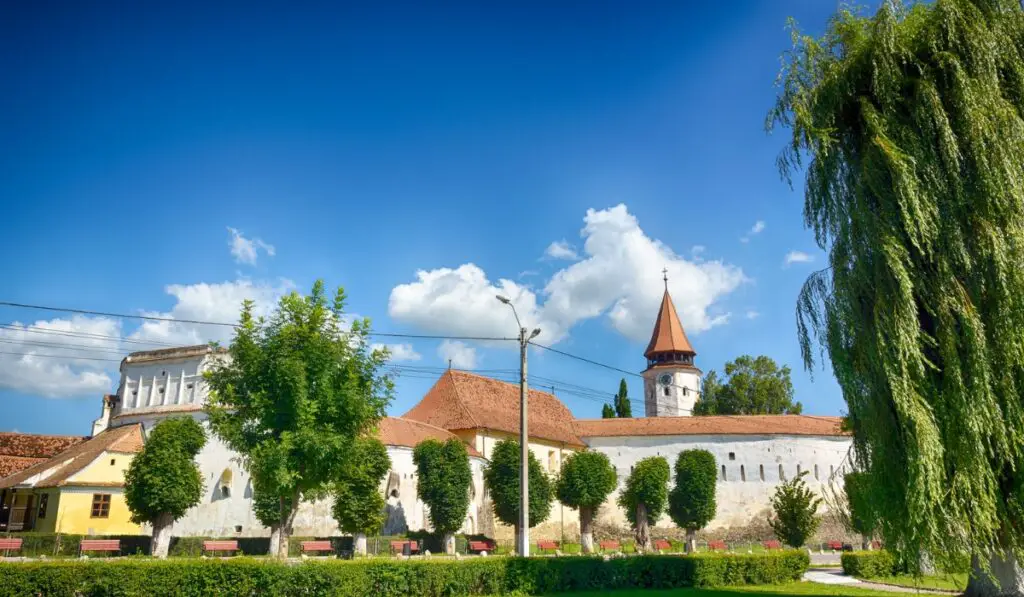
A Day in Prejmer: What to Expect
If you’re expecting just another Transylvanian village with a famous church, you’re in for a delightful surprise. I remember my first foray into this charming hamlet; it felt like stepping into a storybook. From an American living amidst Romania’s magic, here’s a glimpse of a day in Prejmer and some tried-and-tested expat tips.
A Stroll Through the Village
The Atmosphere: Think dusty streets, time-worn houses that have seen centuries pass by, and an unmistakable quiet. No, not a spooky Transylvanian quiet, but a peaceful, soul-soothing silence. The kind that makes you want to pen a novel or, at the very least, a postcard back home.
The Landscape: As you venture out of the fortified church, the landscape rolls out like a green carpet. Lush fields, distant Carpathian peaks playing peek-a-boo, and occasionally, a horse-drawn cart trundling by. It’s pastoral poetry in motion.
The Culture: The village is a beautiful blend of history and modernity. You’ll see kids playing near ancient walls, elderly folks sharing tales of old (some of which, I promise, involve mysterious counts and moonlit nights), and the intoxicating aroma of traditional Romanian dishes wafting from homes.
Local People: Warm, welcoming, and with stories galore. Don’t be surprised if a casual hello turns into an invitation for a homemade ‘țuică‘ (a potent plum brandy) tasting. And trust me, you haven’t truly tasted Romanian cuisine until you’ve had a local ‘mămăligă’ (polenta) dish.
Insider Tips and Tricks from Yours Truly
Local Markets: If you’re after souvenirs, skip the touristy shops. Instead, head to the local markets. You’ll find hand-crafted goods, from intricate lacework to woodcrafts. And always, always haggle. Not in an aggressive manner, but playfully. It’s part of the shopping charm.
Language Basics: While many in Prejmer speak English, especially the younger generation, a few Romanian phrases can go a long way. ‘Mulțumesc’ (thank you) and ‘Bună ziua’ (good day) are good starting points. My American accent still gets chuckles, but the effort is always appreciated.
Dining: There are only a handful of restaurants in this village. Ask a local where they eat. That’s how I discovered the best ‘mămăligă cu brânză’ (polenta with cheese) I’ve ever tasted, in a nondescript eatery called Select.
Recommendations for a Memorable Visit
Best Time to Visit: While Prejmer is a treat all year round, spring and fall bring out its best. Think blossoms and colors. Winters, while picturesque with snow-capped church towers, can be quite cold, so pack accordingly.
What to Pack: Comfortable walking shoes are a must. The village is best explored on foot. Layered clothing works wonders, given the temperate climate. And a rain jacket. Romanian showers are like their folklore – unexpected and enchanting.
Stay Options: Consider staying in a local ‘pensiune’ (guesthouse). It offers a more authentic experience than the regular hotels. Plus, some of these places have histories dating back centuries. Pensiunea Magnolia is my preferred guesthouse in Prejmer.
Local Etiquette: Romanians are big on courtesy. Always greet with a handshake. And if you’re invited into a home, it’s customary (and polite) to bring a small gift. Chocolates, wine, or even a souvenir from your homeland is perfect.
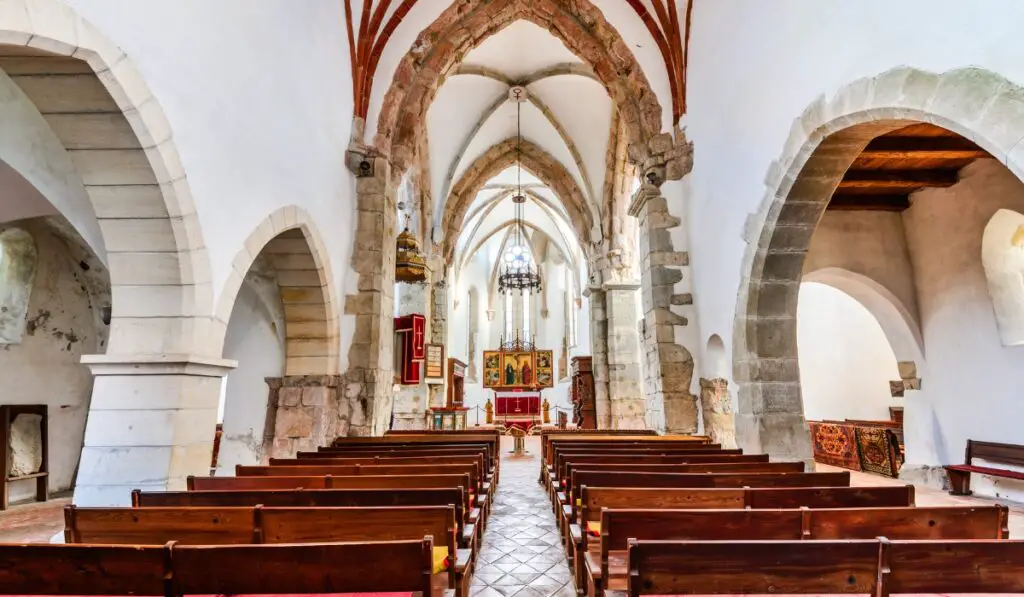
Practical Information for Visitors: Don’t Miss Out!
Visiting Prejmer’s Fortified Church is like getting a backstage pass to Transylvania’s rich history. But to make the most of your trip, here’s the nitty-gritty, down-to-earth info you need, straight from an American living amidst this Romanian charm.
Prejmer Fortified Church Opening Hours & Ticketing
The Prejmer Fortified Church usually opens its grand wooden gates from 9 AM to 6 PM, but these timings can slightly vary with the seasons. My pro tip? Aim to arrive in the mid-morning. Not only will you beat the bigger tourist crowds, but the sunlight casting on the ancient stones makes the church look even more enchanting.
There is a modest entrance fee of 15 lei ($3.75), which, let me assure you, is a small price to pay for the incredible journey back in time. Discounts are available for students – 7 lei ($1.75).
Getting To Prejmer, Romania & Nearby Attractions
By Road: Prejmer is easily accessible by road, and makes for an easy day trip from Brasov. If you’re relying on GPS, remember both “Prejmer” and the Romanian “Cetatea Prejmer” will get you there.
Public Transport: Regular buses and trains connect Prejmer to major cities. From Brașov, you can hop on a bus and be in Prejmer in less than an hour.
Once you’re done soaking up the church’s history, don’t rush off! Nearby, you’ll find Râșnov Fortress, another architectural marvel. Also, Brașov, with its medieval charm and vibrant city life, is a must-visit with plenty of things to do. If you’ve got some time to spend in the area, a trip to Libearty Bear Sanctuary is also a worthy stop!
Remember, fellow adventurers, while history might teach us about the past, it’s our interactions today that make it come alive. So, engage, explore, and enjoy every moment in Prejmer. And don’t forget to say “Mulțumesc” on your way out!
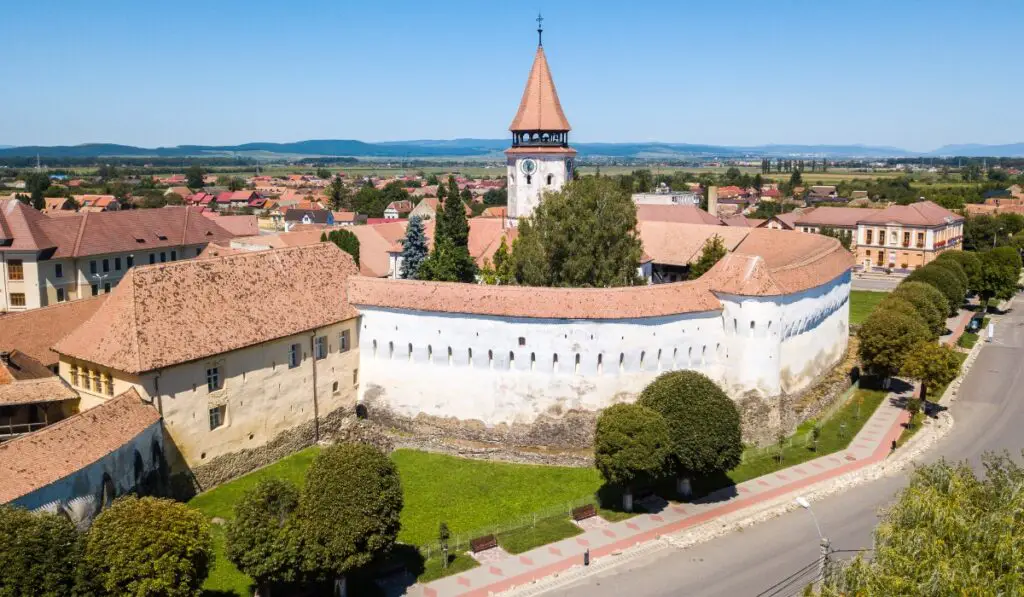
Wrapping Up Your Visit to Prejmer Church & Village
As an American who’s found herself countless miles away from home, I’ve traveled to various corners of Romania. Yet, there’s an undeniable allure to Prejmer that keeps drawing me back. It’s not just the monumental fortified church, although its presence certainly demands attention. It’s the combination of history, community spirit, and a genuine, unembellished Romanian experience that makes Prejmer stand out.
For anyone considering a trip here, I offer this piece of advice: Beyond the photos and guided tours, take a moment to sit in the village square, perhaps with a cup of local coffee, and just observe. You’ll quickly realize that Prejmer isn’t just a tourist spot; it’s a living, breathing community with a rhythm all its own.

